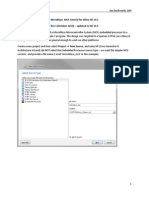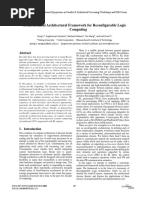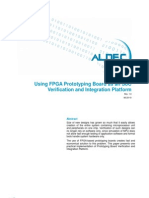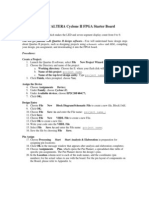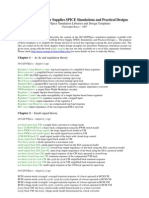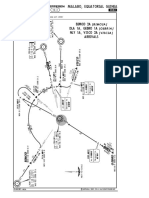FPGA Design Tutorial - Advanced HDL Synthesis
Uploaded by
VIJAYPUTRAFPGA Design Tutorial - Advanced HDL Synthesis
Uploaded by
VIJAYPUTRAFPGA design tutorial: Advanced HDL synthesis
Products
Design Services
Market Solutions
Support
Library
Contacts Implementation (Xilinx flow)
Hardware description languages
FPGA design tutorial contents
Advanced HDL Synthesis for FPGA
This part of the FPGA design tutorial is dedicated to the issues arising when HDL code is synthesized.
Keep FPGA architecture in mind
It is important to know FPGA capabilities in order to produce efficient FPGA designs. When writing HDL code, one should think about how it will be implemented in the particular FPGA. Failure to do this will often lead to area and performance waste. For example, consider a shift register implemented for Xilinx Virtex-4 FPGA: library ieee; use ieee.std_logic_1164.all; entity sreg is port( CLK : in std_logic; CE : in std_logic; RST: in std_logic; DIN : in std_logic; DOUT : out std_logic ); end sreg; architecture behavioral of sreg is signal tmp: std_logic_vector(7 downto 0); begin process (CLK) begin if rising_edge(CLK) then if RST='1' then tmp<="00000000"; elsif CE='1' then tmp<=tmp(6 downto 0)&DIN; end if; end if; end process; DOUT<=tmp(7); end behavioral; It is a valid shift register, but it will be implemented using a chain of 8 flip-flops (spending four Virtex-4 slices). There are cases when we don't actually need to reset a shift register. This will lead to more efficient implementation utilizing SRL16E library element (implemented on LUTs instead of slice flip-flops): library ieee; use ieee.std_logic_1164.all; entity sreg is port( CLK : in std_logic; CE : in std_logic; DIN : in std_logic; DOUT : out std_logic ); end sreg;
FPGA design services 1-CORE Technologies provides FPGA design services of high quality since 2004. Outsourcing FPGA design to Russia will significantly reduce your design costs.
http://www.1-core.com/library/digital/fpga-design-tutorial/advanced-synthesis.shtml[29-Mar-12 9:37:08 PM]
FPGA design tutorial: Advanced HDL synthesis
architecture behavioral of sreg is signal tmp: std_logic_vector(7 downto 0); begin process (CLK) begin if rising_edge(CLK) then if CE='1' then tmp<=tmp(6 downto 0)&DIN; end if; end if; end process; DOUT<=tmp(7); end behavioral; This implementation will use 1 slice instead of 8. The cause of this difference is that SRL16E library element doesn't support reset.
Synthesis constraints
Synthesis constraints are used as guidelines to synthesizer, indicating how it should implement a particular module or signal. Synthesis constraints are not to be confused with implementation constraints, which guide place & route and static timing analysis. Synthesis constraints can be specified in the HDL source, or in separate constraints file. Synthesis constraints depend upon a synthesizer. Specifying synthesis constraints in VHDL source In order to declare a synthesis contraint in VHDL, an attribute must be declared and then linked to the appropriate entity or signal: attribute AttributeName : Type ; attribute AttributeName of ObjectList : ObjectType is AttributeValue ; ObjectList is a list of objects to apply a constraint. Objects that can be assigned constraints are entities, components, labels, signals, variables and types. The following code uses an XST synthesis constraint that forces a multiplier to be implemented in a dedicated DSP48 block. attribute use_dsp48 : string; attribute use_dsp48 of product : signal is "yes"; ... product <= A*B; Specifying synthesis constraints in Verilog source Before Verilog 2001 standard was introduced, Verilog language didn't have any means to specify attributes in source. Synthesis attributes were specified in the comments instead: reg [7:0] dataout[31:0] /* synthesis syn_ramstyle="block_ram" */; These attributes were placed after the signal/module in question. Verilog 2001 (which is now supported by the majority of EDA tools) introduced a syntax element for attribute: (* use_dsp48 = "yes" *) reg [15:0] product;
Inferring Block RAMs
Block RAMs are frequently utilized in FPGA circuits. The usual way to insert a block ram module in the design is to instantiate a component from a vendor-specific library. This solution is often not very desirable because of the lack of portability. Another way that is possible with modern synthesis tools is to write a behavioral description of a RAM module so that a synthesizer can infer that it can be implemented as a block RAM. This behavioral description must be written carefully, otherwise it is possible that a synthesizer won't recognize it. The following example was tested with XST and Synplify synthesizers.
http://www.1-core.com/library/digital/fpga-design-tutorial/advanced-synthesis.shtml[29-Mar-12 9:37:08 PM]
FPGA design tutorial: Advanced HDL synthesis
Consider a dual-port block RAM with 16-bit data words, 6-bit address, one write port and one read port. Here's its VHDL description: library IEEE; use IEEE.std_logic_1164.all; use IEEE.std_logic_unsigned.all; entity mem1 is port ( CLK : in std_logic; WE : in std_logic; WADDR : in std_logic_vector(5 downto 0); RE: in std_logic; RADDR : in std_logic_vector(5 downto 0); DIN : in std_logic_vector(15 downto 0); DOUT : out std_logic_vector(15 downto 0) ); end mem1; architecture behavioral of mem1 is type ram_type is array (63 downto 0) of std_logic_vector (15 downto 0); signal RAM : ram_type; signal read_addr : std_logic_vector(5 downto 0); attribute syn_ramstyle : string; attribute syn_ramstyle of RAM : signal is "block_ram"; begin process (CLK) begin if rising_edge(CLK) then if WE='1' then RAM(conv_integer(WADDR))<=DIN; end if; end if; end process; process (CLK) begin if rising_edge(CLK) then if RE='1' then read_addr<=RADDR; end if; end if; end process; DOUT<=RAM(conv_integer(read_addr)); end behavioral; A Verilog description of the same module: module mem1 (clk,re,we,waddr,raddr,din,dout); input clk; input re; input we; input [5:0] waddr; input [5:0] raddr; input [15:0] din; output [15:0] dout; reg [15:0] ram [63:0]; /* synthesis syn_ramstyle="block_ram" */ reg [5:0] read_addr; always @(posedge clk) begin if (we) ram[waddr] <= din; end always @(posedge clk) begin if (re) read_addr <= raddr; end assign dout = ram[read_addr];
http://www.1-core.com/library/digital/fpga-design-tutorial/advanced-synthesis.shtml[29-Mar-12 9:37:08 PM]
FPGA design tutorial: Advanced HDL synthesis
endmodule syn_ramstyle attribute is intended for Synplify, but XST also recognises it. Using behavioral block RAM descriptions is recommended when possible, since it increases portability and facilitates design reuse. Resources Support Library Careers Contacts
Copyright 1-CORE Technologies, 2004-2009. All product and company names mentioned here are trademarks or registered trademarks of their respective owners. Materials from this site can be distributed freely as long as a link to the 1-CORE Technologies website is provided.
http://www.1-core.com/library/digital/fpga-design-tutorial/advanced-synthesis.shtml[29-Mar-12 9:37:08 PM]
You might also like
- Real-Time Speech Pitch Shifting On An FPGA (Estephan Sawyer Wanninger0% (1)Real-Time Speech Pitch Shifting On An FPGA (Estephan Sawyer Wanninger20 pages
- FPGA-Based Advanced Real Traffic Light Controller System100% (1)FPGA-Based Advanced Real Traffic Light Controller System89 pages
- FPGA Based LED Brightness Controller Using PWMNo ratings yetFPGA Based LED Brightness Controller Using PWM19 pages
- Certification Authorities Software Team (CAST) Position Paper CAST-2No ratings yetCertification Authorities Software Team (CAST) Position Paper CAST-27 pages
- Modeling and Control of Power ElectronicsNo ratings yetModeling and Control of Power Electronics5 pages
- FPGA Tutorial: Monday 07.09.2015 - 14:00No ratings yetFPGA Tutorial: Monday 07.09.2015 - 14:0061 pages
- Tutorial Xilinx Virtex-5 FPGA ML506 Edition: Department of Electrical and Computer EngineeringNo ratings yetTutorial Xilinx Virtex-5 FPGA ML506 Edition: Department of Electrical and Computer Engineering114 pages
- FPGA Training: by Ushasri Merugu 21 Dec 2012No ratings yetFPGA Training: by Ushasri Merugu 21 Dec 20125 pages
- 6 Months Electronics VLSI Design Verification0% (1)6 Months Electronics VLSI Design Verification26 pages
- FSM Implementations: TIE-50206 Logic Synthesis Arto Perttula Tampere University of Technology Fall 2017100% (2)FSM Implementations: TIE-50206 Logic Synthesis Arto Perttula Tampere University of Technology Fall 201725 pages
- How To Create A Microblaze AXI4 DDR3 Embedded System and Stay AliveNo ratings yetHow To Create A Microblaze AXI4 DDR3 Embedded System and Stay Alive12 pages
- Designing With The Nios II Processor and SOPC Builder Exercise ManualNo ratings yetDesigning With The Nios II Processor and SOPC Builder Exercise Manual55 pages
- 03b - FIE - Parcial #3 PLD - Resumen 04c 09No ratings yet03b - FIE - Parcial #3 PLD - Resumen 04c 0936 pages
- Microsemi IGLOO2 FPGA Evaluation Kit User Guide UG0478No ratings yetMicrosemi IGLOO2 FPGA Evaluation Kit User Guide UG047857 pages
- FPGA Selection: LTC2387-18 S.No Pin - Name Pin - No. - ADC Mode PurposeNo ratings yetFPGA Selection: LTC2387-18 S.No Pin - Name Pin - No. - ADC Mode Purpose6 pages
- Computer Architecture As A Multilevel Hierarchical Framework100% (1)Computer Architecture As A Multilevel Hierarchical Framework6 pages
- Using Fpga Prototyping Board As An Soc Verification and Integration PlatformNo ratings yetUsing Fpga Prototyping Board As An Soc Verification and Integration Platform13 pages
- Embedded System Design - Bubble Sort Algorithm, Embedded System Implementation100% (1)Embedded System Design - Bubble Sort Algorithm, Embedded System Implementation29 pages
- Design and FPGA Implementation of Vending Machine: Submitted To: Submitted byNo ratings yetDesign and FPGA Implementation of Vending Machine: Submitted To: Submitted by39 pages
- Lecture 5 - Combinatorial and Sequential Logic100% (3)Lecture 5 - Combinatorial and Sequential Logic76 pages
- Digital System Design Automation With VerilogNo ratings yetDigital System Design Automation With Verilog84 pages
- A Complete 8-Bit Microcontroller in VHDL - FPGA4studentNo ratings yetA Complete 8-Bit Microcontroller in VHDL - FPGA4student20 pages
- Chapter 2 - Architecture of ARM ProcessorNo ratings yetChapter 2 - Architecture of ARM Processor43 pages
- 1.0 The Design of Datapath Decoder: Ece 522/computer OrganizationNo ratings yet1.0 The Design of Datapath Decoder: Ece 522/computer Organization36 pages
- Introduction To Asics: Ni Logic Pvt. LTD., PuneNo ratings yetIntroduction To Asics: Ni Logic Pvt. LTD., Pune84 pages
- Eetop - CN 100 Power Tips For FPGA Designers Stavinov EvgeniNo ratings yetEetop - CN 100 Power Tips For FPGA Designers Stavinov Evgeni409 pages
- Register Transfer Methodology: PracticeNo ratings yetRegister Transfer Methodology: Practice54 pages
- Lec01 Verilog Combinational Circuits DesignNo ratings yetLec01 Verilog Combinational Circuits Design61 pages
- Application-Specific Integrated Circuit ASIC A Complete GuideFrom EverandApplication-Specific Integrated Circuit ASIC A Complete GuideNo ratings yet
- Certification Authorities Software Team (CAST) Position Paper CAST-1No ratings yetCertification Authorities Software Team (CAST) Position Paper CAST-112 pages
- A New Simplified Space-Vector PWM Method For Three-Level InvertersNo ratings yetA New Simplified Space-Vector PWM Method For Three-Level Inverters6 pages
- Virtual Human Hand: Autonomous Grasping Strategy: Esteban Pe Na PitarchNo ratings yetVirtual Human Hand: Autonomous Grasping Strategy: Esteban Pe Na Pitarch26 pages
- Triangle-Comparison Approach and Space Vector Approach To Pulsewidth Modulation in Inverter Fed DrivesNo ratings yetTriangle-Comparison Approach and Space Vector Approach To Pulsewidth Modulation in Inverter Fed Drives38 pages
- Defining The System Defining The System: Computer System State DiagramNo ratings yetDefining The System Defining The System: Computer System State Diagram1 page
- Computer Resource Estimation Development Phase IssuesNo ratings yetComputer Resource Estimation Development Phase Issues1 page
- ECEN 5737: Adjustable Speed Drives: Lecture - 9No ratings yetECEN 5737: Adjustable Speed Drives: Lecture - 919 pages
- Internal Combustion Engines Parts DesignNo ratings yetInternal Combustion Engines Parts Design3 pages
- Malware Analyst Professional - Level 1 SyllabusNo ratings yetMalware Analyst Professional - Level 1 Syllabus3 pages
- Chapter One: Debre Markos University Department of Computer ScienceNo ratings yetChapter One: Debre Markos University Department of Computer Science20 pages
- FGSL/SSG Malabo, Equatorial Guinea: Dla 1A, Gebro 1A Bimod 2A Nly 1A, Visco 2ANo ratings yetFGSL/SSG Malabo, Equatorial Guinea: Dla 1A, Gebro 1A Bimod 2A Nly 1A, Visco 2A2 pages
- Pop! - OS Dock & Application Colour Changer: Issues Pull Requests Actions Projects Security InsightsNo ratings yetPop! - OS Dock & Application Colour Changer: Issues Pull Requests Actions Projects Security Insights4 pages
- Bus Management System'-: Name Reg. No. Roll NoNo ratings yetBus Management System'-: Name Reg. No. Roll No39 pages
- Real-Time Speech Pitch Shifting On An FPGA (Estephan Sawyer WanningerReal-Time Speech Pitch Shifting On An FPGA (Estephan Sawyer Wanninger
- FPGA-Based Advanced Real Traffic Light Controller SystemFPGA-Based Advanced Real Traffic Light Controller System
- Certification Authorities Software Team (CAST) Position Paper CAST-2Certification Authorities Software Team (CAST) Position Paper CAST-2
- Tutorial Xilinx Virtex-5 FPGA ML506 Edition: Department of Electrical and Computer EngineeringTutorial Xilinx Virtex-5 FPGA ML506 Edition: Department of Electrical and Computer Engineering
- FSM Implementations: TIE-50206 Logic Synthesis Arto Perttula Tampere University of Technology Fall 2017FSM Implementations: TIE-50206 Logic Synthesis Arto Perttula Tampere University of Technology Fall 2017
- How To Create A Microblaze AXI4 DDR3 Embedded System and Stay AliveHow To Create A Microblaze AXI4 DDR3 Embedded System and Stay Alive
- Designing With The Nios II Processor and SOPC Builder Exercise ManualDesigning With The Nios II Processor and SOPC Builder Exercise Manual
- Microsemi IGLOO2 FPGA Evaluation Kit User Guide UG0478Microsemi IGLOO2 FPGA Evaluation Kit User Guide UG0478
- FPGA Selection: LTC2387-18 S.No Pin - Name Pin - No. - ADC Mode PurposeFPGA Selection: LTC2387-18 S.No Pin - Name Pin - No. - ADC Mode Purpose
- Computer Architecture As A Multilevel Hierarchical FrameworkComputer Architecture As A Multilevel Hierarchical Framework
- Using Fpga Prototyping Board As An Soc Verification and Integration PlatformUsing Fpga Prototyping Board As An Soc Verification and Integration Platform
- Embedded System Design - Bubble Sort Algorithm, Embedded System ImplementationEmbedded System Design - Bubble Sort Algorithm, Embedded System Implementation
- Design and FPGA Implementation of Vending Machine: Submitted To: Submitted byDesign and FPGA Implementation of Vending Machine: Submitted To: Submitted by
- A Complete 8-Bit Microcontroller in VHDL - FPGA4studentA Complete 8-Bit Microcontroller in VHDL - FPGA4student
- 1.0 The Design of Datapath Decoder: Ece 522/computer Organization1.0 The Design of Datapath Decoder: Ece 522/computer Organization
- Eetop - CN 100 Power Tips For FPGA Designers Stavinov EvgeniEetop - CN 100 Power Tips For FPGA Designers Stavinov Evgeni
- Application-Specific Integrated Circuit ASIC A Complete GuideFrom EverandApplication-Specific Integrated Circuit ASIC A Complete Guide
- Certification Authorities Software Team (CAST) Position Paper CAST-1Certification Authorities Software Team (CAST) Position Paper CAST-1
- A New Simplified Space-Vector PWM Method For Three-Level InvertersA New Simplified Space-Vector PWM Method For Three-Level Inverters
- Virtual Human Hand: Autonomous Grasping Strategy: Esteban Pe Na PitarchVirtual Human Hand: Autonomous Grasping Strategy: Esteban Pe Na Pitarch
- Triangle-Comparison Approach and Space Vector Approach To Pulsewidth Modulation in Inverter Fed DrivesTriangle-Comparison Approach and Space Vector Approach To Pulsewidth Modulation in Inverter Fed Drives
- Defining The System Defining The System: Computer System State DiagramDefining The System Defining The System: Computer System State Diagram
- Computer Resource Estimation Development Phase IssuesComputer Resource Estimation Development Phase Issues
- Chapter One: Debre Markos University Department of Computer ScienceChapter One: Debre Markos University Department of Computer Science
- FGSL/SSG Malabo, Equatorial Guinea: Dla 1A, Gebro 1A Bimod 2A Nly 1A, Visco 2AFGSL/SSG Malabo, Equatorial Guinea: Dla 1A, Gebro 1A Bimod 2A Nly 1A, Visco 2A
- Pop! - OS Dock & Application Colour Changer: Issues Pull Requests Actions Projects Security InsightsPop! - OS Dock & Application Colour Changer: Issues Pull Requests Actions Projects Security Insights










